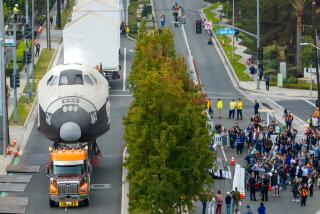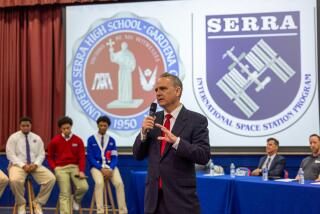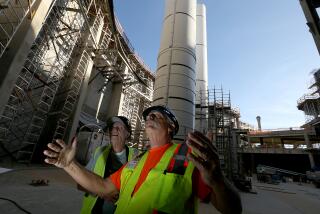BUENA PARK : All Systems Were Go for the Shuttle
- Share via
Neck cranked skyward, 10-year-old Matthew Cheney carefully surveyed the looming clouds.
Ordinarily, the subtleties of cumulus and cirrus would be about as exciting to him as a trip to the principal’s office. But Thursday was anything but ordinary for the freckle-nosed Matthew. He was helping to land the space shuttle.
With the help of the National Aeronautics and Space Administration, Cheney and his classmates at San Marino Elementary School got a hands-on look at the complexities of space flight. The 72 fourth-graders participated in a mock space-shuttle flight, communicating by computer with a school in Ohio to conduct the daylong experiment.
Begining at 8:30 a.m., the students carefully tracked the flight of the shuttle, feeding hourly weather reports to Mission Control in Ohio. San Marino students were given the task of watching the weather because the mock shuttle would land in California. In the meantime, at University School in Ohio, where an actual space-shuttle simulator was installed for six student astronauts to use, students reported back on the condition of the “Centennial” and results of experiments being performed in space.
NASA supplied the simulator as well as lessons and other supplies for the space journey.
“Hopefully, the students will better understand the importance of being prepared,” said mission commander and fourth-grade teacher Carol Turkus-Workman. “They will see how the weather affects not only people on Earth, but space travel as well.”
Just one hour into their mission and at a brisk 50 degrees, a group of students hovered around a map of the world, struggling to understand latitude and longitude while another group telecommunicated with its Ohio counterparts.
After taking her turn at tracking, 9-year-old Jennifer Corbin marveled at the complexity of it all.
“This is a big thing, gosh,” Jennifer said. She wondered about the weather and how the Centennial would fair if it rained. “If they slipped when they landed, they might crash,” she said logically.
Jennifer, wearing a Bart Simpson sweat shirt, explained: “We have an important job. Once the shuttle gets out of orbit, we have to tell them whether they can land or not.”
Those not on the main team did their own experiments, such as launching balloons to test jet propulsion, building weather vanes and designing space shuttles. Several space lessons had been planned to enhance the students’ understanding of the test flight.
The entire mission took 24 hours to complete and was overseen by Linda Delzeit, a parent. Delzeit, director of a public telecommunications network, guided the students through the often-difficult commands when “talking” with Mission Control. She continued reporting until the landing, which was scheduled for 4:30 a.m., long after the students had gone home.
The students communicated with their fellow space watchers with a free computer network supplied by Cal State Fullerton. The university donated their telecommunication lines and other groups also chipped in services to the school for the flight. Besides advanced technology, simple weather instruments such as a basic thermometer was also on hand for the students to use.
While performing their tasks, many students quickly found that as with previous space-shuttle missions, the first time around was not always a success. “When all else fails, try again,” Turkus-Workman told a disappointed balloon launcher whose rocket failed to take flight. “NASA has done it many times.”
And what did the budding astronauts think of their day in space? “I don’t want to be an astronaut,” said Marcus Castillo, while busily drawing a picture of a satellite. “I want to be on the ground.”
More to Read
Sign up for Essential California
The most important California stories and recommendations in your inbox every morning.
You may occasionally receive promotional content from the Los Angeles Times.










